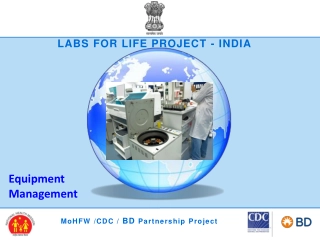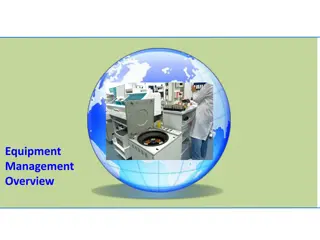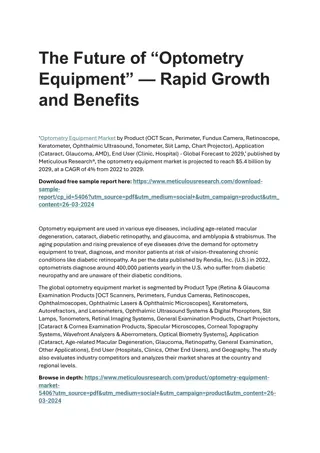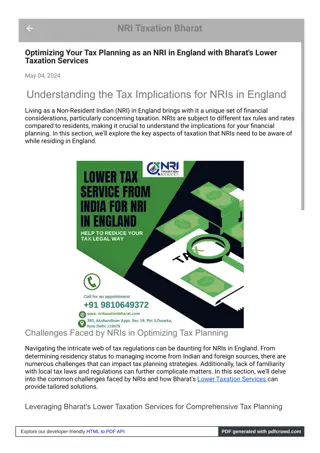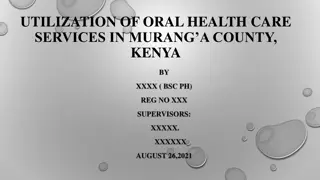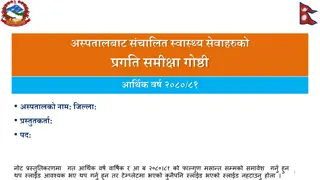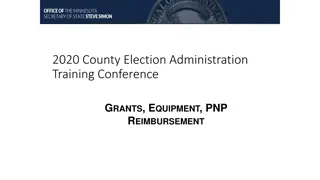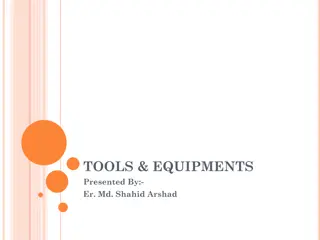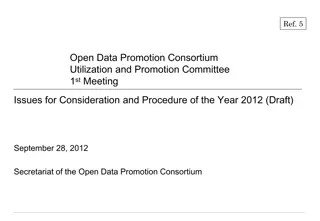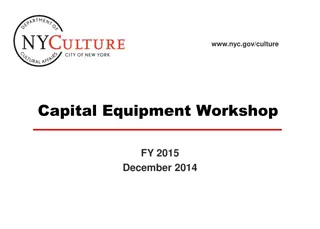
Challenges and Benefits of Hospital Equipment Management
Discover the importance of equipment utilization, management strategies, benefits like greater safety and decreased downtime, along with challenges faced in hospital equipment management. Learn how optimizing equipment usage can lead to cost savings and improved patient care.
Download Presentation

Please find below an Image/Link to download the presentation.
The content on the website is provided AS IS for your information and personal use only. It may not be sold, licensed, or shared on other websites without obtaining consent from the author. If you encounter any issues during the download, it is possible that the publisher has removed the file from their server.
You are allowed to download the files provided on this website for personal or commercial use, subject to the condition that they are used lawfully. All files are the property of their respective owners.
The content on the website is provided AS IS for your information and personal use only. It may not be sold, licensed, or shared on other websites without obtaining consent from the author.
E N D
Presentation Transcript
In the present health care scenario, increasing operational efficiency and reducing costs, while improving service provided to the patient are a constant challenge.
What does Equipment Utilization Means The extent to which the productive capacity of an equipment is used during a specified period of time and can be expressed in percentage (%). Utilization = Recorded time of Actual working time / Available time
Why Equipment Management is Important Era of cost intensive Medicare Demand for improved diagnostic facilities Sophisticated equipment with modern technology Medical devices are assets that directly affect human lives They are considerable costly investments Equipment maintenance program keep the hospital equipment in a reliable, safe and available for use when it is needed Such a programme prolongs the useful life of the equipment and cost effective To optimize utilization to obtain maximum return for capital invested Better utilization results in quick Break-even-point Optimal patient handling and rapid turn over minimizes cost Quality patient care, Safety and satisfaction
Benefits Greater Safety Decreased Production Down Time Fewer large Scale & Repetitive Repairs Less Cost for Simple Repairs Less Standby Equipment Required Better Spare parts Control Proper Identification f Items
Challenges The Challenges involved in hospital equipment management are the following: Longer downtime of equipment. (Period of time that a system fails to provide or perform its primary function). Hospital administrator s inadequate knowledge on importance on routine hospital equipment maintenance and service. Absence or little budgetary support for maintenance. The lack of the framework for regular auditing system.
Lack of knowledge and innovative ways of using new equipment. Delayed fault reporting, example BP Apparatus patch up with plaster. The difficulty in obtaining spare parts. Failure to provide technical training to operators. Obsolete equipment left unattended in maintenance room and wards. The absence of evidence-based information system on health care technology for decision making.
Medical Equipment Non-Medical / Facility Engg Equipment IT Equipment
The hospital medical equipment management is a management cycle that s starts from EQUIPMENT MANAGEMENT PROGRAM - Planning Equipment Management program Starts from procurement and end at condemnation and disposal - Procurement MANAGEMENT - Acquisition EQUIPMENT CONDEMNATION PROCUREMENT - Installation - Commission - De-commission & Disposal
Financial Management *Monitoring cost *Managing the budget Personnel Management *To provide support to the maintenance program so that program objectives are achieved Service Vendors *Equipment manufactures *Independent service organizations
Operational Management SOP s IPM FREQUENCY PRIORITIZATION OPERATIONAL MANAGEMENT USE AND USER ERROR CMMS COMMUNICATION LOG BOOK
Operational management consists of Proper design and installation of equipment Equipment control & Asset management Effective predictive / preventive maintenance program Repetitive servicing and overhaul of equipment Work Order Management
Periodical measuring instruments Adequate lubrication, cleaning and painting Lowering breakdowns Data Quality Management Route cause analysis Proper corrective action program Quality assurance program Patient Safety Risk Assessment calibration of equipment and
Components of a Maintenance Programme Maintenance IPM Corrective maintenance Preventive Maintenance Inspection
Equipment Management Programme An effective medical equipment management programme consists of PLANNING IMPLEMENTATION MANAGEMENT
Predictive maintenance Preventive maintenance Routine maintenance Planned maintenance Breakdown maintenance or corrective maintenance
Objectives Minimize loss of productive time Minimize repair time & cost Keep productive assets in working condition Minimize accidents and safe operations Minimize total maintenance cost Improve quality of products & outcome
Importance Dependability of service Assured quality Prevent equipment failure Cost control Huge investment in equipment & ROI in acceptable time frame.
Predictive Maintenance In this, sensitive instruments (eg. vibration analysers, amplitude meters, audio gauges, optical tooling and resistance gauges) are used to predict trouble. Conditions can be measured on a continuous basis and this enables the maintenance people to plan for an overhaul.
Preventive management It is undertaken before the need arises and aims to minimize the possibility of un -anticipated production interruption or major breakdowns. Usually carried out by in-house resources Scheduling and strict monitoring Keeping critical spares inventory is essential Helps to minimize downtime, service continuity and reduce expenditures on maintenance of equipment
Routine maintenance This includes activities such as Periodic inspection - daily visual checks cleaning Lubrication Calibration of measuring instruments
Planned maintenance It involves the inspection of all plant and equipment, machinery, buildings according to a predetermined schedule in order to service overhaul, lubricate or repair, before actual break down or deterioration in service occurs. Half yearly & Yearly maintenance
Breakdown Maintenance Occurs when there is a work stoppage due to equipment breakdown Maintenance becomes repair work Seeks to get the equipment back into operation as quickly as possible To control the investment in replacement / spare equipment.
Maintenance Scheduling Scheduling refers to timing and sequences of operations. It is an important segment of the equipment utilization & control activity as well as the service operations like equipment maintenance
Importance of scheduling Facilitates optimum use of highly paid maintenance staff Equipment can be utilized effectively Eliminates undue interruptions in the service flow Eliminates chances of sudden breakdown Facilitates proper sequence in maintenance service
Training For the safety of the patient and the user, proper training is critical for both the user and the technical staff. Self Study: 1) Reading the equipment service and training manuals 2) Using additional self-study materials provided by the manufacturer 3) Using materials provided by a third party. One-to-one training provided by a more experienced person from inside the organization Manufacturer's training programs. 1) Specifically designed for equipment technicians and provided by the Indian agent
Condemnation Completed life time (7 to 10 years) Electronic equipemets Beyond economic repair (BER) Non functional and obsolete Functional and obsolete Functional but hazardous Procedure / documents required for condemnation. 1) History sheet 2) Recommendation of maintenance Committee 3) Condemnation committee recommendation to HOD 4) Approval of competent authority for disposal and right off.
Issues How much maintenance is needed? What size maintenance crews must be used? Can maintenance be sub-contracted? Should maintenance staff be covered by wage incentive schemes? Can effective use be made of computers for analyzing and scheduling activities?
Control of EMP Authorized by an official 1. Maintenance schedule 2. Issue materials against proper authorization 3. Maintenance budgets 4. Equipment records 5.
Performance Monitoring and Measurements Availability=Total available hours Total breakdown hours ----------------------------------------------------- Total available hours MTBF = Total available hours Breakdown hours -------------------------------------------------- Number of breakdown MTTR = Total breakdown hours ---------------------------- Number of breakdowns
Service Contract TYPE OF SERVICE FREQUANCY COST Internal Staff provides initial response. External staff follows up as when required. At least four visit a year AMC Fixed Charges Only service provided Renewed ever year Varying response time available as needed CMC charges service , minor spares and consumables free CMC Full Service With Parts (WARRANTY) 5 to 10 Years Quick response available at all times for maintenance and repair Fixed Charge parts to be provided on payment
Several healthcare institutions out source equipment management and facility services Major equipment under AMC / CMC with OEM Appropriate and qualified service vendor selection Control mechanism to be developed to ensure effectiveness of service contract program (SLA-Service level agreement) Usually a nodal person identified to manage equipment service program
Conclusion To ensure optimum utilization of equipment, continuity of patient care with greater quality at reduced cost, it is imperative for health care facilities to have a effective equipment management system.


